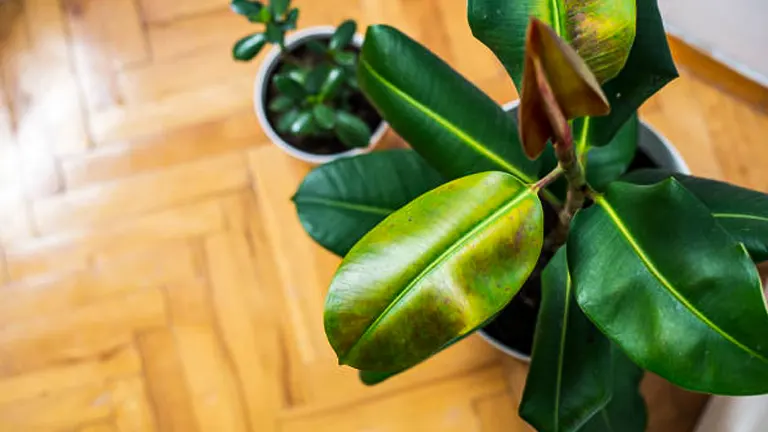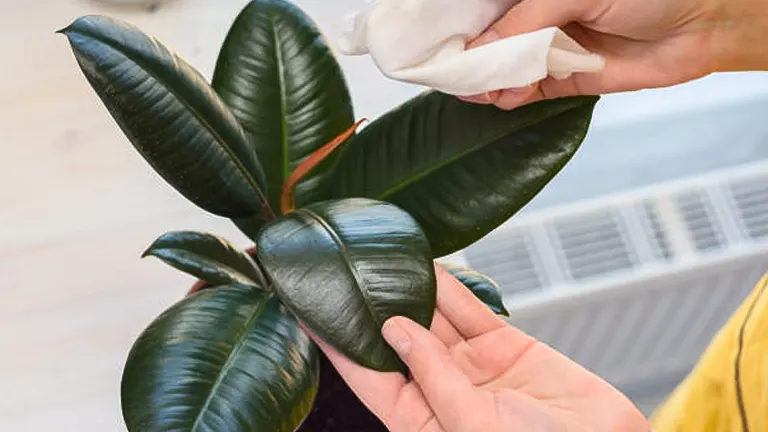How to Fertilize Rubber Plants: Essential Techniques for Vibrant Growth in 2024
- April 9, 2024
- 0 comment
Discover essential techniques on how to fertilize rubber plants in 2024 to ensure vibrant growth. Your guide to lush foliage. In the quest for a greener sanctuary, the rubber plant, with its glossy leaves and robust stature, has emerged as a favorite among indoor gardening enthusiasts. But even the hardiest plants require a little help to reach their full potential. As we step into 2024, understanding the nuances of fertilizing rubber plants has never been more essential.

This guide is designed not just to teach you the basics of fertilization but to unlock the secrets of cultivating a thriving rubber plant in your home. Whether you’re a seasoned green thumb or a budding plant parent, our expert tips and essential techniques will ensure your rubber plant not only survives but flourishes, transforming your space into a lush, vibrant oasis. Join us as we delve into the world of rubber plant care, where every bit of knowledge leads you closer to achieving that enviable lush foliage.
Table of Contents
- Understanding Rubber Plant Nutritional Needs
- The Right Fertilizer for Your Rubber Plant
- When to Fertilize Rubber Plants
- How to Fertilize Rubber Plants: Step-by-Step Guide
- Common Mistakes to Avoid in Fertilizing Rubber Plants
- Advanced Tips for Expert Care
- Conclusion
- FAQs
Understanding Rubber Plant Nutritional Needs

Rubber plants (Ficus elastica), while resilient, require a well-balanced diet to unlock their growth potential and display their lush foliage. The key macronutrients—nitrogen (N), phosphorus (P), and potassium (K)—serve distinct functions in plant health and development:
- Nitrogen (N) is fundamental for chlorophyll production, the green pigment responsible for photosynthesis. It promotes vigorous leaf growth and gives rubber plants their rich, dark green color.
- Phosphorus (P) plays a critical role in energy transfer within the plant, aiding in root development and the maturation of flowers and fruits. It’s essential for the overall vigor of the plant.
- Potassium (K) is involved in regulating plant metabolism and aids in water uptake. It contributes to overall plant health, including disease resistance and the structural integrity of the stems.
Beyond these, micronutrients such as magnesium (Mg), calcium (Ca), and sulfur (S) are crucial, albeit in smaller quantities. Magnesium is a central component of the chlorophyll molecule, calcium is vital for cell wall structure and growth, and sulfur is a key player in various metabolic processes and chlorophyll production.
Environmental stresses, improper watering, and soil conditions can lead to nutrient imbalances. For instance, a deficiency in magnesium often manifests as interveinal chlorosis, where the space between leaf veins turns yellow while the veins remain green. Calcium deficiency, on the other hand, can lead to tip burn in young leaves and poor root development.
To illustrate these nutritional needs more clearly, here’s a table outlining the key nutrients, their functions, and deficiency symptoms in rubber plants:
| Nutrient | Function | Deficiency Symptoms |
|---|---|---|
| Nitrogen (N) | Promotes leaf growth and green color. | Yellowing of older leaves, stunted growth. |
| Phosphorus (P) | Supports root development and energy transfer. | Dark green leaves, delayed growth. |
| Potassium (K) | Regulates metabolism, water uptake, and disease resistance. | Yellowing at leaf edges, weak stems. |
| Magnesium (Mg) | Central component of chlorophyll, aids in photosynthesis. | Interveinal chlorosis, leaf curling. |
| Calcium (Ca) | Essential for cell wall structure and growth. | Tip burn in young leaves, poor root growth. |
| Sulfur (S) | Involved in metabolic functions and chlorophyll production. | Yellowing of young leaves, stunted growth. |
For those interested in the scientific analysis, it’s crucial to understand that rubber plants typically thrive in soil with a pH range of 5.5 to 7.0, which optimizes nutrient availability. Nutrient uptake can be inhibited by extreme pH levels: for instance, at a low pH, calcium and magnesium become less available, while high pH can lock out iron, manganese, and phosphorus.
Additionally, employing a balanced fertilizer with an NPK ratio of 3:1:2 is ideal for promoting healthy growth and addressing the primary nutritional needs of rubber plants. During the growing season, a half-strength, water-soluble fertilizer applied monthly can meet these needs without the risk of nutrient burn, which can occur with over-fertilization.
Understanding these detailed nutritional requirements and managing them effectively is key to nurturing a thriving, vibrant rubber plant. This approach not only satisfies the curiosity of enthusiasts and nerds alike but also elevates the level of care provided to these magnificent houseplants.
The Right Fertilizer for Your Rubber Plant

Fertilizing rubber plants (Ficus elastica) is a nuanced art that marries scientific precision with horticultural practice. The decision between organic and synthetic fertilizers is the first step in a complex process tailored to promote the health and growth of these magnificent plants.
Organic vs. Synthetic Fertilizers
- Organic Fertilizers: These are derived from natural sources such as compost, manure, bone meal, and seaweed. They release nutrients slowly into the soil, mimicking the natural nutrient cycle. This slow release minimizes the risk of nutrient runoff and over-fertilization, fostering a healthy microbiome within the soil. Organic options also improve soil structure and moisture retention over time, contributing to the long-term health of the rubber plant.
- Synthetic Fertilizers: Formulated from chemical compounds, synthetic fertilizers provide nutrients in a more readily available form. This can be particularly advantageous during the rubber plant’s active growth phases, when nutrient demands are higher. However, the rapid release of nutrients requires careful application to avoid potential root burn and nutrient leaching, which can detrimentally affect both the plant and the environment.
The NPK Ratio
The NPK ratio represents the proportion of Nitrogen (N), Phosphorus (P), and Potassium (K) – three primary nutrients critical to plant health. For rubber plants, a balanced NPK ratio of 3-1-2 is often advocated. This configuration supports robust leaf development, a strong root system, and overall vitality.
- Nitrogen (N) is vital for foliage growth, giving leaves their vibrant green color.
- Phosphorus (P) supports the development of roots and flowers.
- Potassium (K) plays a crucial role in water uptake, enzyme activation, and overall plant health.
Tailored Recommendations Based on Growth Stages
- Seedlings and Young Plants: A higher nitrogen concentration (e.g., NPK 3-1-2) promotes vigorous leaf growth and establishment.
- Mature Plants: Maintaining a balanced NPK ratio supports sustained health. During active growth periods, a slight increase in nitrogen can be beneficial.
- Recovering or Stressed Plants: Plants under stress from repotting, disease, or damage may benefit from a balanced formula with a slight increase in phosphorus to encourage root development and recovery.
Scientific Insight: The Optimal Fertilization Schedule
- Spring to Summer (Active Growth): Apply a balanced, water-soluble fertilizer every 4-6 weeks.
- Fall to Winter (Dormant Period): Reduce fertilization to every 8-12 weeks, depending on the plant’s appearance and soil nutrient levels.
Comparative Analysis Table
| Fertilizer Type | NPK Ratio | Release Rate | Best Use Case | Pros | Cons |
|---|---|---|---|---|---|
| Organic | Variable | Slow | All stages, particularly long-term | Improves soil health, low risk of over-fertilization | Lower nutrient concentration |
| Synthetic | 3-1-2 | Fast | Active growth periods | Immediate nutrient availability | Higher risk of root burn and environmental impact |
Unique Insight: Nutrient Absorption Efficiency
Rubber plants have a remarkable ability to absorb and utilize nutrients with high efficiency, particularly when the soil pH ranges between 5.5 and 7.0. This optimal pH level maximizes nutrient availability, enhancing the plant’s uptake of nitrogen, phosphorus, and potassium. Regular soil testing can ensure that the pH remains within this ideal range, thereby facilitating optimal growth and health.
When to Fertilize Rubber Plants

Fertilization timing for rubber plants (Ficus elastica) is not merely about adhering to a calendar; it’s about synchronizing with the plant’s natural growth cycles and understanding its physiological responses to seasonal changes. These tropical natives channel their energy into growth predominantly in the spring and summer, leveraging longer daylight hours and warmer temperatures. This period demands an increased supply of nutrients to support the rapid development of foliage and roots.
Seasonal Fertilization Guide
- Spring to Summer (Growth Phase): This is when rubber plants enter their most vigorous growth phase. Fertilizing every 4-6 weeks with a balanced, slow-release NPK fertilizer encourages healthy leaf development and stem growth. Optimal nutrient ratios and the type of fertilizer can significantly influence the plant’s overall health and growth rate.
- Autumn (Transition Phase): As daylight hours shorten and temperatures drop, rubber plants begin to slow their growth. Reducing fertilization frequency to once every 8-10 weeks supports this gradual transition, providing necessary nutrients without overwhelming the plant.
- Winter (Dormant Phase): During the colder months, rubber plants essentially enter a state of dormancy. Pausing fertilization allows the plant to rest, mirroring the natural resting phase it would experience in its native habitat. This break is crucial for preventing nutrient accumulation in the soil, which can lead to root burn and other growth issues.
Monitoring Plant Health: Signs and Signals
- Slow Growth: A clear indication that your rubber plant may need fertilization. However, discerning between naturally slower growth rates during certain seasons and nutrient deficiencies is key.
- Pale Leaves: Often a sign of nitrogen deficiency, pale leaves suggest that it’s time for a nutrient boost. Ensuring the fertilizer has an appropriate NPK ratio can address this issue.
The Science of Seasonal Fertilization
Rubber plants adapt their growth patterns based on environmental cues. During their active growth phase, they require an uptick in nutrients to support the development of new leaves and stems. The shift in seasons significantly affects these physiological processes, necessitating adjustments in fertilization practices to align with the plant’s natural rhythms.
Fertilization Schedule and Recommendations
| Season | Fertilization Frequency | Recommended NPK Ratio | Additional Tips |
|---|---|---|---|
| Spring to Summer | Every 4-6 weeks | 3-1-2 | Use a balanced, slow-release fertilizer; monitor for signs of growth. |
| Autumn | Once every 8-10 weeks | 3-1-2 | Prepare for slower growth; adjust frequency accordingly. |
| Winter | Pause | N/A | Allow the plant to rest; resume fertilization in spring. |
Unique Insight: Optimizing Nutrient Absorption
Scientific studies have shown that rubber plants have an optimal nutrient absorption range, tied closely to soil pH levels. A pH of 5.5 to 6.5 is ideal for maximizing the uptake of nitrogen, phosphorus, and potassium. Regular soil testing and amendments can maintain this pH range, ensuring your rubber plant benefits fully from each fertilization.
How to Fertilize Rubber Plants: Step-by-Step Guide
Step 1: Choose the Right Fertilizer
- Select a Fertilizer: Opt for a balanced, water-soluble fertilizer with an NPK ratio of 3-1-2, which is ideal for supporting lush foliage and strong roots.
- Organic vs. Synthetic: Decide between organic fertilizers (for slow, sustained release of nutrients and improved soil health) and synthetic fertilizers (for immediate nutrient availability).
Step 2: Test the Soil (Optional but Recommended)
- Check Soil pH: Use a soil pH tester to ensure the soil is between 5.5 and 7.0, optimizing nutrient absorption.
- Nutrient Test: A soil test kit can help determine if specific nutrients are lacking, allowing for more targeted fertilization.
Step 3: Prepare the Fertilizer
- Dilution: Dilute the fertilizer according to the manufacturer’s instructions to prevent over-concentration, which can harm the plant.
- Preparation: If using granular fertilizer, ensure it’s evenly mixed with water. For liquid fertilizers, shake well before diluting.
Step 4: Water the Plant
- Moisten the Soil: Water your rubber plant thoroughly a few hours before fertilizing. This helps prevent root burn by ensuring the fertilizer is evenly distributed throughout moist soil.
Step 5: Apply the Fertilizer
- Application: Pour the diluted fertilizer around the base of the plant, avoiding direct contact with the leaves or stem to prevent chemical burn.
- Quantity: Follow the recommended dosage on the fertilizer package. Over-fertilizing can be more harmful than under-fertilizing.
Step 6: Observe the Plant
- Growth Monitoring: After fertilization, watch your plant’s response over the following weeks. Increased leaf size and a more vibrant green color are good indicators of successful fertilization.
- Signs of Over-Fertilization: Yellowing leaves, leaf burn, or a white crust on the soil surface are signs of over-fertilization and require immediate attention.
Step 7: Adjust Fertilization Schedule Based on Season
- Active Growth Phase (Spring and Summer): Fertilize every 4-6 weeks.
- Transition Phase (Autumn): Reduce to once every 8-10 weeks.
- Dormant Phase (Winter): Pause fertilization to allow the plant to rest.
Step 8: Repeat and Refine
- Regular Schedule: Continue the fertilization routine, adjusting as needed based on the plant’s response and seasonal changes.
- Annual Review: Reassess your fertilization practice yearly, including soil tests to refine your approach further.
Additional Tips:
- Cleaning Leaves: Periodically clean your rubber plant’s leaves with a damp cloth to ensure they can efficiently photosynthesize, complementing your fertilization efforts.
- Repotting Consideration: If you’ve recently repotted your rubber plant, delay fertilization for a few weeks to allow the plant to adjust to its new environment without the added stress of absorbing nutrients.
- Record Keeping: Keep a log of fertilization dates, amounts, and plant responses to develop an optimized fertilization plan tailored to your specific rubber plant over time.
Common Mistakes to Avoid in Fertilizing Rubber Plants
- Over-fertilizing: This is perhaps the most common mistake. Signs of over-fertilization include salt buildup on the soil’s surface, yellowing or browning of leaf edges, and wilted leaves. If you suspect over-fertilization, leach the soil by running water through it for several minutes to flush out excess nutrients.
- Wrong Fertilizer Type: Using a fertilizer with the wrong NPK ratio can lead to imbalanced growth or nutrient deficiencies. Always choose a fertilizer suited for rubber plants or general indoor plants.
- Ignoring Seasonal Changes: Failing to adjust fertilization schedules according to the season can stress your plant, leading to poor growth or dormancy issues. Respect the natural growth cycle of your rubber plant for optimal results.
Advanced Tips for Expert Care

Even with the basics down, there’s always room to refine your approach to care for rubber plants, ensuring they not only grow but thrive in your indoor environment. These advanced tips can help you tailor your care routine to your plant’s unique needs.
- Observation Is Key: Regularly inspect your plant for signs of growth, discoloration, or pest infestation. Early detection of any issues allows for prompt intervention, keeping your plant healthy.
- Adjust According to Environment: The amount of light, humidity, and temperature in your home affects your rubber plant’s needs. Plants in brighter light may require more frequent fertilization than those in lower light conditions. Similarly, plants in drier environments might benefit from a slightly increased frequency of watering and fertilization due to faster soil drying.
- Repotting and Root Health: When repotting, consider a fresh application of a slow-release fertilizer to give your plant a nutrient boost in its new environment. Always check the roots for health during repotting; healthy roots are white and firm, while unhealthy roots may be brown and mushy.
- Customize Your Fertilization Plan: No two plants are the same, and as such, they may not thrive on a generic care plan. Consider creating a custom fertilization schedule based on your plant’s specific reactions to fertilization, growth patterns, and environmental conditions.
Related Post
- How to Fertilize a Mango Tree Effectively: Tips and Tricks for Healthy Growth
- How to Fertilize Apple Trees: Essential Tips for a Bountiful Harvest
- How to Fertilize Lemon Trees: Secrets for Thriving Citrus
- How to Fertilize Avocado Tree: A Step-by-Step Guide for Lush Growth
Conclusion
Caring for rubber plants goes beyond simple water and sunlight. Proper fertilization is a nuanced but critical aspect of ensuring these magnificent plants reach their full potential. By understanding their nutritional needs, timing fertilizations appropriately, and avoiding common pitfalls, you can foster a thriving indoor garden. Remember, the key to vibrant growth lies in the balance—providing enough nutrients without overdoing it and adjusting care techniques as your plant and its environment change.
FAQs
- What is the best fertilizer ratio for rubber plants in 2024?
A balanced NPK ratio of 3-1-2 is ideal for rubber plants. This ratio supports lush foliage, strong roots, and overall health, catering to the plant’s needs for nitrogen, phosphorus, and potassium. - How often should I fertilize my rubber plant during its active growth period?
During the spring and summer months, fertilize your rubber plant every 4-6 weeks. This frequency supports the plant’s rapid growth phase by providing essential nutrients more frequently. - Can I use organic fertilizers for my rubber plant, and are they better than synthetic ones?
Yes, you can use organic fertilizers, which are derived from natural sources and release nutrients slowly, enriching the soil ecosystem. Whether organic is better than synthetic depends on your gardening preferences and the specific needs of your plant. Organics reduce the risk of over-fertilization and improve soil health over time, but synthetics offer a quicker nutrient release, which can be beneficial in certain growth stages. - What should I do if I over-fertilize my rubber plant?
If you over-fertilize, first stop fertilizing and water the plant thoroughly several times to help flush out excess nutrients. If the plant shows signs of stress, such as leaf burn or yellowing, consider repotting it with fresh soil. - Is it necessary to fertilize rubber plants in winter?
No, it’s best to pause fertilization during the winter months. Rubber plants typically enter a dormant phase with minimal growth, so they require fewer nutrients. Over-fertilizing during this time can lead to nutrient accumulation and potential harm. - How does the potting mix affect fertilization for rubber plants?
The potting mix plays a crucial role in nutrient retention and drainage. A well-draining, aerated, and nutrient-rich potting mix can enhance fertilizer effectiveness. Consider mixes with perlite or vermiculite to improve drainage and peat or coconut coir for moisture retention. - Can I make my own fertilizer for my rubber plant?
Yes, you can create a homemade fertilizer using compost, coffee grounds, or eggshells for a more natural approach. However, ensure to research and use the correct proportions to meet the NPK needs of your rubber plant. - How do I know if my rubber plant needs fertilization?
Signs that your rubber plant may need fertilization include slower than usual growth, pale or yellowing leaves, and a lack of new leaves during the growing season. It’s essential to balance fertilization with other care aspects like proper watering and lighting to ensure the plant’s overall health.
This guide is designed to equip you with essential fertilization strategies for rubber plants, guiding you towards enhancing the cultivation of your rubber plant specimens. Here’s to achieving a space filled with robust, thriving rubber plants in 2024!

Benjamin Brooks
Forestry AuthorGreetings! I'm Benjamin Brooks, and my journey over the past 15 years has revolved around the fascinating realms of content creation, expertise in snow clearing, and the intricate world of lumberjacking and landscaping. What began as a simple curiosity about the natural world and heavy machinery has evolved into a passionate profession where my love for crafting words intertwines seamlessly with my lumberjacking and garden skills.













Leave your comment